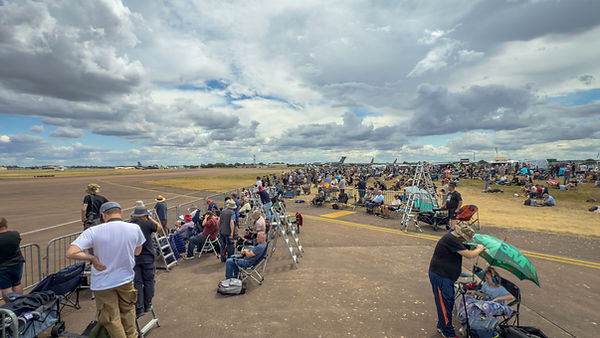

Park and View
In this section you will find information on how Park and View works inside RAF Fairford.


Arrivals and Departure Day
Here’s a detailed guide to the official “Park and View” (P&V) areas at RIAT (Royal International Air Tattoo), a must-know for first-timers and a helpful refresh for regulars. These areas are run by RIAT themselves, offering unique photo opportunities and close-up views of all the action, especially during arrivals, rehearsals, and departures.
As there are no suitable parking facilities on the public highways and pedestrian walkways surrounding RAF Fairford, the Park & View enclosures are provided for your safety and convenience.
In-advance tickets for Wednesday, Thursday and Monday are now available to book online however they sell out quick so I would advise to purchase them as soon as tickets are released , but there will be more tickets available on the gate on a first come, first served basis.
(PERSONALLY I HAVE NEVER SEEN THEM SELL OUT ON THE GATE)
Park & View ticket includes
-
Parking for ticket holders (opens at 6.00am)
-
Toilets
-
Disabled Parking (limited)
-
Pay catering
-
A stepladder enclosure within Park and View East
Arrivals & Rehearsal-validations (Wednesday–Thursday )
-
Teams like the Red Arrows, Frecce Tricolori, RAF Typhoon, Italian C27J Spartan will practice full displays.
-
Perfect chance to capture formation flypasts from an off-centre perspective.
Show Days (Friday, Saturday and Sunday)
-
Park and View on show days are closed, as the showground is open to the general public.
Departures Day (Monday)
-
One of the most exciting days. as we see al aircraft take off and some in rare formations. (great day for photographers)
-
Non-stop stream of departing aircraft, many using full afterburners.
-
Best spot for heat distortion, wave-offs, wing dips, and rare angles.
Planning Your Day
The Park & View enclosures are open daily from 07:30 to 18:00, providing visitors with the opportunity to observe all aircraft departures.
Visitor Information
-
Arriving before the gates open increases the likelihood of securing a position along the front row.
-
For those less concerned with being at the front, arrival from around 08:00 is generally sufficient.
-
The queue looks long as seen in these photos, however it does move quickly. There are two queues. Purchased Tickets Only and Pay on the Gate.
-
Once you are within the enclosure you can enter and exit via a hand stamp.
Catering/Toliets
Both the East and West Park & View enclosures offer on-site catering, including mobile units serving hot food, breakfast options, coffee, and ice cream.
Toilet facilities, including accessible units, are provided within the enclosures for ticket holders. Please note that visitors remaining in the car park do not have access to these facilities or catering services.
Viewing Areas (Step Ladder)
The East and West Park & View enclosures both provide excellent viewing opportunities. Each features a designated Step Ladder Enclosure, giving visitors an enhanced view of the taxiway, which is particularly advantageous for photography. The FIAT G.91 and the Apache is taken from a Step Ladder, with no one in view.
At Park & View West, the rear section of the main viewing area is set on slightly raised ground, ensuring good visibility even for those not positioned at the front.
Where is Park and View Located?
The East and West Park & View enclosures are marked out in the maps, showcasing the location to help plan your day, and deciding what photos you want to plan.
Wind Direction
This plays an important role in planning your day, because even when Runway 27 is in use, some aircraft parked at the western end may still depart from Runway 09. If you are aiming to capture a particular aircraft in the air, be sure to factor this into your choice of viewing location.
Directions to Park and View.
Both Park & View East and West are well signposted, with East located conveniently near the Red Entrance used on show days. To reach Park & View West, you must drive through the small village of Marston Meysey, so please do so carefully and respectfully as it is a quiet, narrow, and residential area.









P&V EAST
P&V WEST




RIAT Departure Day Photography Cheat Sheet
CAMERA SETTINGS QUICK REFERENCE
Fast Jets, Cargo/Large Aircraft
-
Mode: Shutter Priority or Manual
-
Shutter Speed: 1/1000 – 1/2500 sec
-
Aperture: f/7.1 – f/11
-
ISO: Auto or 100–400 (sunny), 800+ (cloudy)
-
AF Mode: Continuous (AI Servo / AF-C)
-
Drive Mode: High-Speed Burst
-
Propeller Aircraft / Helicopters
-
Shutter Speed: 1/125 – 1/320 sec (to blur propellers)
-
Pan smoothly with aircraft for best results
-
COMPOSITION & ANGLES
-
Takeoffs Shoot side-on for rotation; front angles for drama
-
Climbs Track vertically, use burst mode to capture peak
-
Wing Waves Keep tracking after wheels up – waves often come late
-
Heavy Jets Leave space in frame for size and context
-
Smoke/Heat Distortion Zoom out slightly or reposition to minimize effect
-
LIGHTING CHECKS
-
Time of Day-Lighting Direction
-
Early Morning-Park & View East: sun behind you
-
Midday-Harsh light, watch shadows, use higher aperture
-
Afternoon-Park & View West: better light angles
TIPS TO REMEMBER
-
Back-button focus helps lock on and track aircraft more accurately.
-
Start tracking the aircraft before it rotates.
-
Keep your horizon level, especially for side-on shots.
-
Don’t zoom too tight, leave room for cropping later.
-
Watch your background clutter (crowds, vehicles, tents).
-
WHAT TO PACK (Photography Gear)
-
DSLR or Mirrorless Camera
-
Telephoto lens for example (100–400mm / 150–600mm)
-
Wide-angle lens (for static displays)
-
Extra batteries (at least 2)
-
Spare memory cards
-
Lens cloth / rain cover
-
Tripod/monopod (optional but handy for heavy lenses)
-
Portable charger or SSD for backups
-
Pro Shot Ideas
-
Take off Rotation (wheels lifting)
-
Afterburner Climb
-
Wing Wave Goodbye
-
Close-up Details (markings, gear, engines)






























